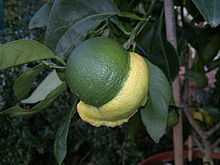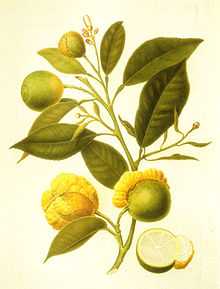Bizzaria
| Bizzaria | |
|---|---|
 | |
| The Florentine Bizzaria | |
| Scientific classification | |
| Kingdom: | Plantae |
| (unranked): | Angiosperms |
| (unranked): | Eudicots |
| (unranked): | Rosids |
| Order: | Sapindales |
| Family: | Rutaceae |
| Genus: | Citrus |
| Species: | C. medica + C. aurantium |
The Bizzaria of Florence (citrus medica + citrus aurantium), which is probably the first graft chimera obtained, is a graft between the Florentine citron and sour orange. It produces branches of regular Florentine citron including such leaves, and from the other side branches of sour orange. The most interesting part of it is the middle shoot, which mixes characteristics of both. The fruit contains characteristics of both citron and orange.

This is not like a regular somatic hybrid which is due to plant sexuality; its offspring is intermediate showing influences of both parents. But the Florentine Bizzaria, named after its origin, shows an unusual fruit which has both characteristics distinctly expressed in close proximity.
The plant's name has a number of different spellings, e.g. Bizaria,[1] Bizzarria,[2] Bizarria,[3] and even Bizarre.[4]
Discovery
The Bizzaria was discovered in 1640 by Pietro Nati at the Villa named Torre degli Agli, which belonged to the wealthy Panciatichi banking family. The Bizzaria was thought to be lost when it was rediscovered in year 1970s by Paolo Galleotti, the head gardener of the Villa di Castello and of The Boboli Gardens in Florence.
See also
- Citrus hybrids
- Grafting
- Citrus taxonomy
References
| Wikimedia Commons has media related to Villa Reale di Castello (Firenze). |
